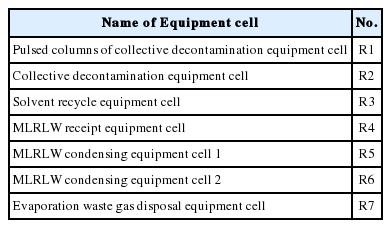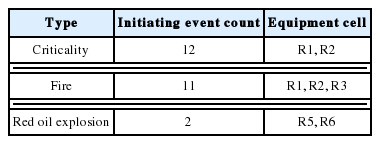Initiating Events Study of the First Extraction Cycle Process in a Model Reprocessing Plant
Article information
Abstract
Background:
Definition and grouping of initiating events (IEs) are important basics for probabilistic safety assessment (PSA). An IE in a spent fuel reprocessing plant (SFRP) is an event that probably leads to the release of dangerous material to jeopardize workers, public and environment. The main difference between SFRPs and nuclear power plants (NPPs) is that hazard materials spread diffusely in a SFRP and radioactive material is just one kind of hazard material.
Materials and Methods:
Since the research on IEs for NPPs is in-depth around the world, there are several general methods to identify IEs: reference of lists in existence, review of experience feedback, qualitative analysis method, and deductive analysis method. While failure mode and effect analysis (FMEA) is an important qualitative analysis method, master logic diagram (MLD) method is the deductive analysis method. IE identification in SFRPs should be consulted with the experience of NPPs, however the differences between SFRPs and NPPs should be considered seriously.
Results and Discussion:
The plutonium uranium reduction extraction (Purex) process is adopted by the technics in a model reprocessing plant. The first extraction cycle (FEC) is the pivotal process in the Purex process. Whether the FEC can function safely and steadily would directly influence the production process of the whole plant-production quality. Important facilities of the FEC are installed in the equipment cells (ECs). In this work, IEs in the FEC process were identified and categorized by FMEA and MLD two methods, based on the fact that ECs are containments in the plant.
Conclusion:
The results show that only two ECs in the FEC do not need to be concerned particularly with safety problems, and criticality, fire and red oil explosion are IEs which should be emphatically analyzed. The results are accordant with the references.
1. INTRODUCTION
China aspires after spent fuel reprocessing with the rapid development of its nuclear industry. Hence the research on reprocessing plants becomes more and more important in China. Meanwhile, probabilistic safety assessment (PSA) has been a requisite methodology for safety analysis and design amelioration of nuclear facilities. In several countries such as UK, France and Japan PSA for nuclear fuel cycle facilities especially for reprocessing plants have been developed. The International Atomic Energy Agency (IAEA) issued a technical document [1] for conducting PSA for non-reactor nuclear facilities.
Definition and grouping of initiating events (IEs) are not only important steps to PSA analysis but also research basis of the entire level 1 PSA for nuclear power plants (NPPs). IAEA defined an IE in a NPP [2] as that “an IE is an event that creates a disturbance in the plant and has the potential to lead to core damage, depending on the successful operation of the various mitigating systems in the plant”. However, for a spent fuel reprocessing plant (SFRP), an IE is an event that probably leads to the release of dangerous material jeopardizing workers, public and environment. This is because differences exist between NPPs and SFRPs (see Table 1).
Since the research on IEs for NPPs is indepth around the world, several general methods to identify IEs are shown as follows.
Reference of lists in existence;
Review of experience feedback;
Qualitative analysis method such as failure mode and effect analysis (FMEA) and hazard and operability analysis (HAZOP);
Deductive analysis method such as master logic diagram (MLD).
IE identification in SFRPs should consult the experience of NPPs and consider the differences. The FMEA and MLD methods were applied to identify initial events of the first extraction cycle (FEC) in a representative spent fuel reprocessing facility adopting the plutonium uranium reduction extraction (Purex) process. Then initial events were categorized based on the characteristics in a SFRP.
2. MATERIALS AND METHODS
2.1 Study survey of IEs in SFRPs around the world
UK, France and Japan are the representative countries to research IEs in SFRPs around the world. British Nuclear Fuel plc (BNFL) adopted HAZOP means to identify IEs in the PSA to the Thermal Oxide Reprocessing Plant (THORP) located at Sellafield Site [3-8]. BNFL carried out HAZOP in two stages, HAZOP I and HAZOP II. The HAZOP I examined the plant area by area to identify potential generic fault conditions. The HAZOP II is a detailed rigorous examination of each line, vessel and instrument for potential fault conditions.
The Compagnie Générale des Matieres Nucléaires (COGEMA) and the Institut de Radioprotection et de Sûreté Nucléaire (IRSN) identified IEs by review of experience feedback during conducting PSA for the UP3-A SFRP [9]. Japan Nuclear Cycle Development Institute (JNC) adopted two qualitative analysis methods, FMEA and HAZOP in the PSA for the Tokai Reprocessing Plant (TRP) [10]. The JNC selected twenty processes from the TRP according to the following viewpoints:
Amount of radioactive material;
Existence of the flammable material;
Necessity of criticality control.
Then the JNC identified IEs in the TRP.
2.2 IE Identification in the FEC
2.2.1 Introduction of the model plant
In 1983, the Chinese central government made the strategy for the integrity of Chinese nuclear industry that reprocessing must be developed corresponding to the development of nuclear power. After 15 years of design and verification the project of the model reprocessing plant of China (MRPC) was started in 1998. The MRPC adopts the Purex process. The MRPC formally received the first batch of spent fuel of China in September 2003. The construction of the MRPC was basically finished in December 2005. The MRPC succeeded in hot debugging in December 12, 2010.
2.2.2 Introduction of the FEC
The FEC is the pivotal process in the Purex process [11, 12]. Whether this process can function safely and steadily would directly influence the production process of the whole plant-production quality, harvest rate of metal and radiation safety of the whole plant building. Important facilities of the FEC are installed in the ECs shown in Table 2. The following functions should be accomplished in this process under the condition of nuclear safety.
Collective decontamination and separation cycle: Collective decontamination of uranium and plutonium i.e. primary separation of uranium, plutonium and fission fragments is performed after receipt the feed liquid mixed up in the shearing and dissolution process;
Solvent recycle: Regenerate of contaminated organic solvent produced in the process.
Disposal of Medium level radioactive liquid waste (MLRLW): Receive liquid waste from everyday production, examination and maintenance, then evaporate and concentrate the liquid waste.
2.2.3 IE Identification
2.2.3.1 Qualitative analysis
FMEA has been adopted as a qualitative analysis method in this study. FMEA was first applied for fault analysis to the plane motor in U.S. in 1957. FMEA generally includes the following 4 aspects:
Obtain a better understanding of the object system;
Analyse fault types and causes of the systemic components;
Analyse effects of various faults to components and the system;
Summarize results and propose correctional measures.
Important facilities in the FEC are pulsed columns, mixer-settler and tanks. The following items have been considered in the FMEA analysis:
Criticality of solution in the equipment is considered as an IE if the content of heavy metal is high;
Fire of the equipment is considered as an IE when there are much organics and the radioactive activity is greater than or equal to 104 MBq in the equipment;
Incident of equipment erosion is not considered as an IE when the radioactive activity is less than 105 MBq in the equipment.
The FMEA results show that there are several IEs―criticality, fire, erosion, red oil explosion, filter core failure and function failure. The idiographic results were not proposed here for conciseness.
2.2.3.2 Deductive analysis
MLD method has been adopted as a deductive analysis method in this study. As a logical tool to deduce qualitative relations between object events and IEs, MLD can be considered as a high level fault tree. The object event of the complete MLD for a NPP is large release of radioactive material or core melt. However, the object event of the MLD for the MRPC is the release of hazardous material as discussed in the introduction. For the FEC, since there are no arresting incendive, explosive and poisonous material, all accidents would lead to radioactivity exceeding the limit, the object event of the MLD for the process is defined as radioactivity exceeding the limit. The MLD was determined according to assessment analysis for equipment in the process (see Figure 1).
2.2.3.3 Summation of IE identification
FMEA and MLD were adopted in this study to identify IEs. The above two methods combine, complement and validate each other, so consistent results were obtained, further analysis could be made based on this research.
2.2.3.4 IE grouping
The purpose of IE grouping is to reduce quantity of PSA for facilities, i.e. reduce the workload. The main principles for IE grouping are two points: First, success criteria for the correlative front systems of IEs in a group are identical; Second, protective and mitigable measures of protective systems for these events are basically identical. IEs, accident sequences and final states of a SFRP are relatively simple. However, characters of a SFRP are distinct and present the tendency of diversification. Therefore grouping of multi-IEs is difficult [13]. This work reckons that existence of ECs are intrinsic conditions for the IE grouping. Because an EC is also safety containment, basically, IEs of the same type in the same EC can be categorized in a group. The results of IE grouping were not proposed here for conciseness.
3. RESULTS AND DISCUSSION
The results of this study show that types of IEs of the FEC in the MRPC include criticality, fire, equipment erosion and red oil explosion. There are 52 IEs identified in total. IEs with severe consequences are shown in Table 3. Based on the facts that important facilities are in stalled in ECs in the MRPC, IEs are categorized. IE-groups with severe consequences are shown in Table 4.
Tables 8 and 9 show that only two ECs (R4 and R7) in the FEC do not need to be concerned particularly with safety problems while the other five ECs should be concerned. Safety systems should be enhanced, and operation-regulation systems should be consummated to prevent accidents or to mitigate the consequences of accidents.
4. CONCLUSION
FMEA and MLD were applied to identify IEs of the FEC in the MRPC by referring to correlative research reports of other SFRPs around the world and considering characters of the MRPC.
Since IE grouping principal for a NPP is not practical for a SFRP, application of the principal is difficult to group IEs rationally and effectively for a SFRP. Considering that the difference between NPPs and SFRPs is that there are ECs in a SFRP, IE grouping principal for a SFRP was proposed: IEs of the same type in the same EC can be categorized in a group. Then, the grouping principal was applied to group IEs of the FEC in the MRPC. The results show that the grouping principal is advanced in logic simplicity and maneuverability, so the grouping principal can be applied for all production processes in a SFRP.
Based on the study in this work, PSA including fault tree and event tree analysis to the FEC in the MRPC is continued.
Acknowledgements
The author would like to acknowledge Dr. Guoqing ZHANG, who is my schoolfellow and obtained a Ph.D. at Karlsruhe Institute of Technology in German, for his help to improve the English expression of the article.




